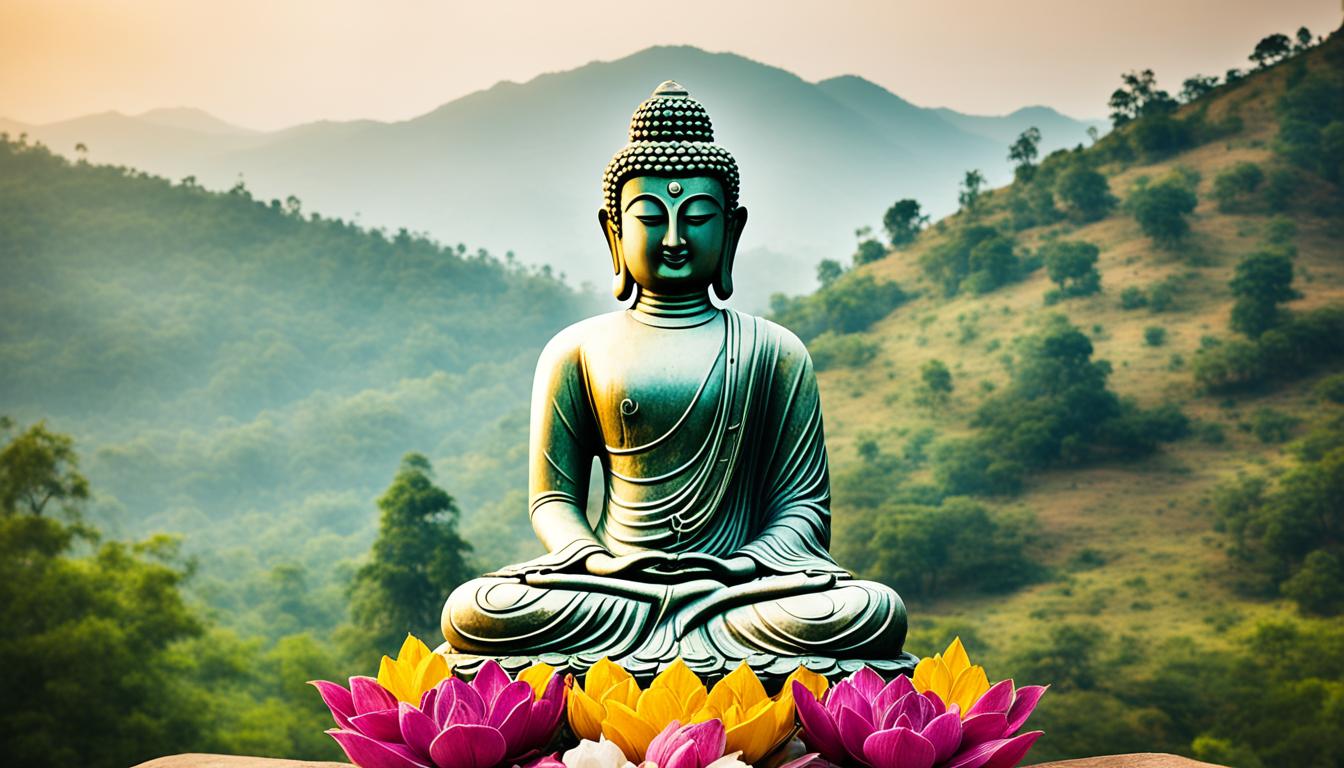Have you ever wondered about the origins of Buddhism? Did you know that its roots can be traced back to the ancient land of India? Contrary to popular belief, Buddhism is not solely a product of the Far East. In fact, India holds a rich and significant history in the development and spread of this profound philosophy. So, let’s embark on a journey to explore the fascinating world of Buddhism in India, unearthing its deep historical connections and its enduring legacy.
Key Takeaways:
- Buddhism originated in India in the Kingdom of Magadha, now Bihar.
- The teachings of Gautama Buddha form the foundation of Buddhism.
- Buddhism spread throughout India during Emperor Ashoka’s reign.
- Despite a decline, there has been a revival of Buddhism in India.
- India is home to numerous Buddhist sites and monuments of historical and religious significance.
The Life and Teachings of Gautama Buddha
Siddhartha Gautama, also known as the Buddha, was born into a wealthy family in Nepal. He witnessed the suffering and impermanence of life, driving him to seek a deeper understanding of existence and a path to alleviate human suffering. With a burning desire for enlightenment, Gautama left behind his life of luxury and embarked on a spiritual journey.
After years of intense meditation and self-discipline, Gautama achieved enlightenment while meditating under a bodhi tree. This transformative experience led him to become the Buddha, meaning “the enlightened one.”
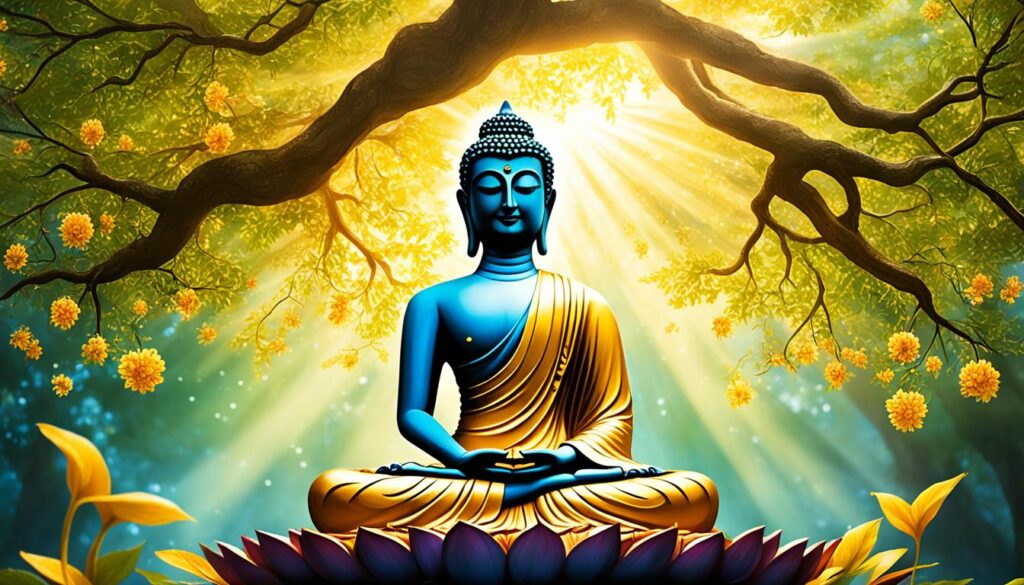
The Buddha’s teachings center around the Middle Way, guiding individuals to find a balanced path between extreme self-mortification and indulgence. He emphasized the importance of understanding human suffering and the ultimate goal of liberation from the cycle of rebirth (samsara).
Central to Buddhist philosophy are the Four Noble Truths, which acknowledge the reality of suffering, its causes, and the possibility of its cessation. The Buddha also expounded on the Eightfold Path, a set of ethical guidelines and practices that lead to liberation and enlightenment.
The Four Noble Truths
- Suffering exists (dukkha)
- Suffering arises from craving and attachment
- Suffering can be overcome and transcended
- There is a path to the cessation of suffering
The Eightfold Path
- Right Understanding
- Right Intention
- Right Speech
- Right Action
- Right Livelihood
- Right Effort
- Right Mindfulness
- Right Concentration
The teachings of the Buddha have had a profound impact, not only on Buddhism as a religion but also on philosophy, psychology, and mindfulness practices worldwide. By following the Middle Way and embracing the Four Noble Truths and the Eightfold Path, individuals can find liberation and cultivate greater compassion, wisdom, and inner peace.
| Birth Name | Nicknames | Birthplace | Enlightenment | Teachings |
|---|---|---|---|---|
| Siddhartha Gautama | The Buddha, Shakyamuni | Lumbini, Nepal | Bodh Gaya, India | Middle Way, Four Noble Truths, Eightfold Path |
Spread and Development of Buddhism in India
Buddhism gained prominence and spread throughout India during the reign of Emperor Ashoka in the 3rd century BCE. Ashoka, also known as Ashoka the Great, played a crucial role in the promotion and development of Buddhism in India. He embraced Buddhism after witnessing the devastating consequences of war and violence during the Kalinga War.
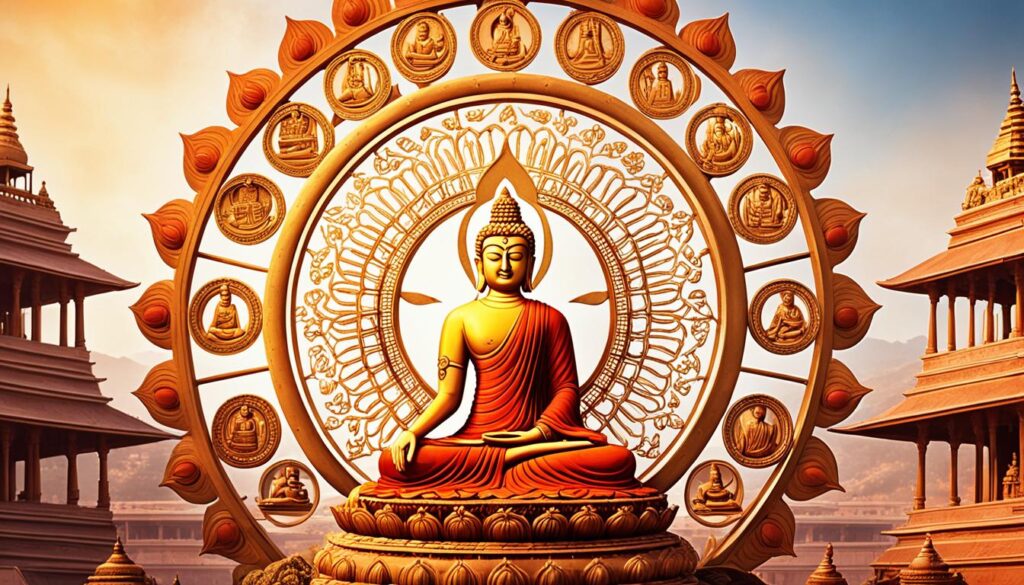
Inspired by the teachings of the Buddha, Ashoka dedicated himself to spreading Buddhism and promoting its values of peace, non-violence, and compassion among his subjects.
Ashoka’s patronage of Buddhism resulted in the proliferation of Buddhist monasteries, stupas, and other sacred sites throughout his vast empire. He sponsored the construction of numerous monastic institutions, which served as centers of learning and spiritual practice for Buddhist monks and nuns.
Buddhist Monasteries Sponsored by Ashoka
| Monastery Name | Location | Description |
|---|---|---|
| Nalanda | Bihar | Renowned center of Buddhist learning and one of the oldest universities in the world. |
| Sarnath | Uttar Pradesh | Site of the Buddha’s first sermon and an important pilgrimage destination for Buddhists. |
| Ghositarama | Odisha | Ashoka’s childhood monastery, known for its architectural grandeur and Buddhist art. |
Despite Ashoka’s efforts, the practice of Buddhism declined in India after the collapse of the Gupta Empire in the 7th century CE. The decline was further accelerated by the invasions of Muslim rulers, who viewed Buddhism as a rival to Islam.
By the end of the 12th century, Buddhism had largely disappeared from the Indian subcontinent, except for the Himalayan region and isolated pockets in south India. However, the legacy of Ashoka’s patronage and the ancient Buddhist monasteries he sponsored continue to inspire and attract pilgrims and historians to this day.
Revival of Buddhism in India
In the 19th century, a resurgence of interest in Buddhism took place in India, as people sought to reconnect with their spiritual roots. Key figures and movements played crucial roles in this revival, breathing new life into the ancient teachings of the Buddha.
The Maha Bodhi Society:
The Maha Bodhi Society, founded by Sri Lankan monk Anagarika Dharmapala, emerged as a pivotal force in the revival of Buddhism in India. The society was dedicated to restoring and preserving the ancient Buddhist sites scattered throughout the country. By undertaking conservation efforts and promoting pilgrimage to these sacred sites, the Maha Bodhi Society reignited the flame of Buddhism in the hearts of the Indian people.
The Dalit Buddhist Movement:
A significant movement that contributed to the resurgence of Buddhism in India was the Dalit Buddhist movement led by B.R. Ambedkar. The movement attracted a large number of followers from the Dalit community, who saw Buddhism as a path to liberation from the social and economic oppression they faced. By embracing Buddhism, the Dalits sought to break free from the hierarchical caste system and find equality and dignity.
Tibetan Buddhism in India:
Another significant factor in the revival of Buddhism in India was the arrival of Tibetan refugees and the establishment of the Tibetan government in exile in Dharamshala. Tibetan Buddhism, with its rich traditions and practices, took root in India, attracting followers and practitioners from different walks of life. The presence of Tibetan Buddhist monasteries and institutions further strengthened the Buddhist community in India and contributed to the revival of the ancient faith.
The revival of Buddhism in India not only restored a valuable cultural and spiritual heritage but also provided solace and guidance to those seeking inner peace and enlightenment.
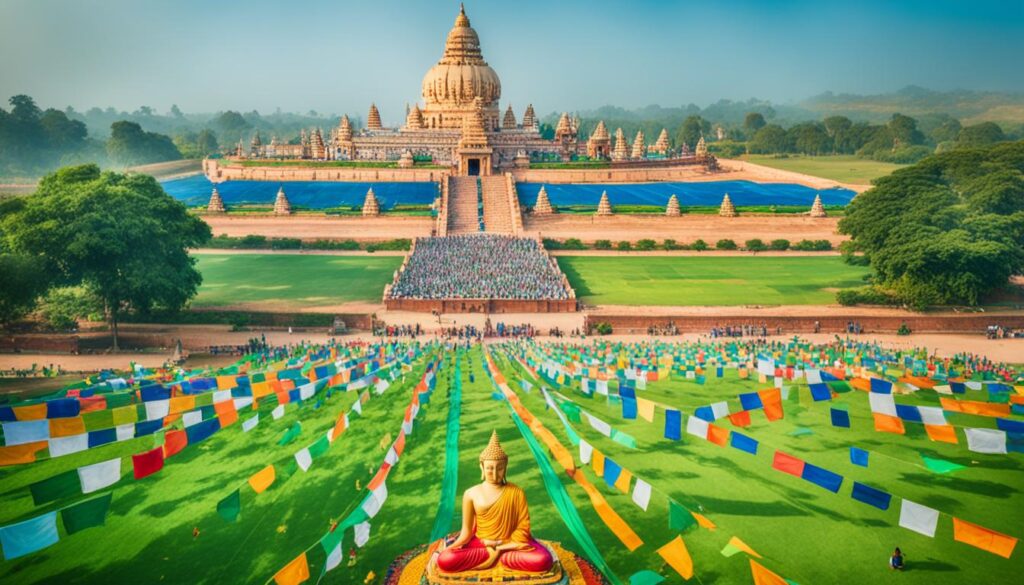
Key Figures and Movements:
- The Maha Bodhi Society, founded by Anagarika Dharmapala, focused on restoring and preserving ancient Buddhist sites in India.
- The Dalit Buddhist movement, led by B.R. Ambedkar, attracted a significant number of followers from the Dalit community.
- The arrival of Tibetan refugees and the establishment of the Tibetan government in exile in Dharamshala brought Tibetan Buddhism to India.
Buddhist Sites and Monuments in India
India is a land rich in Buddhist heritage, with numerous sites and monuments that hold historical and religious significance. These sacred places attract pilgrims and tourists from around the world, offering a glimpse into the profound teachings and ancient traditions of Buddhism.
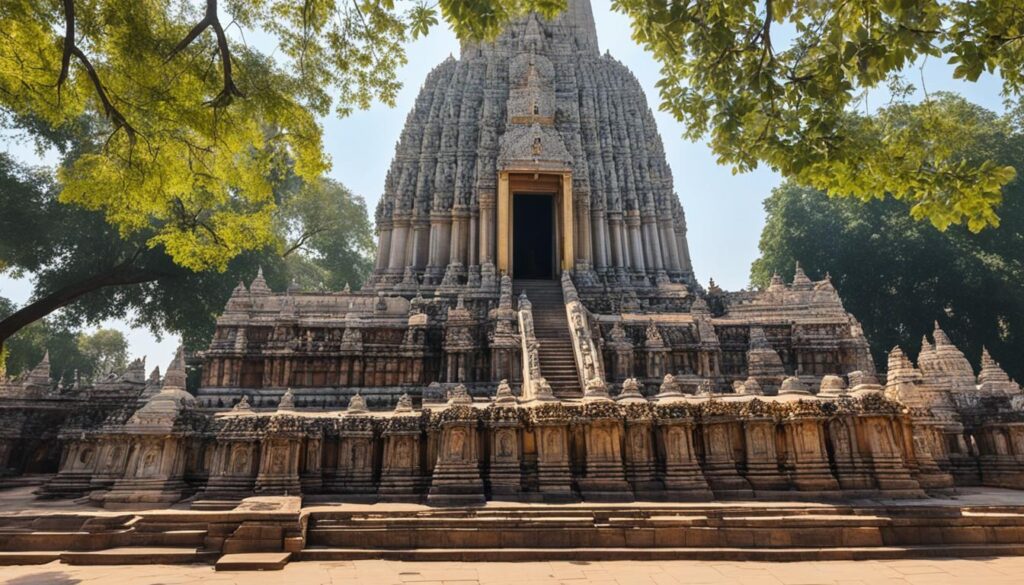
Sarnath: The Wheel of Dharma
Sarnath, located near the holy city of Varanasi, holds great importance in Buddhism. It is the place where Gautama Buddha delivered his first sermon, known as the Wheel of Dharma. This significant event marks the beginning of Buddhist teachings and holds deep spiritual significance for followers of the faith.
Bodh Gaya: The Pilgrimage to Enlightenment
Bodh Gaya is the sacred site where Gautama Buddha attained enlightenment. Under the shelter of the famed bodhi tree, he meditated and achieved ultimate spiritual awakening. Pilgrims from all over the world visit Bodh Gaya to pay homage and experience the profound serenity of this hallowed ground.
Sanchi: The Great Stupa
Sanchi is renowned for its Great Stupa, a magnificent Buddhist monument that stands as a symbol of devotion and architectural excellence. The stupa is adorned with intricate carvings and sculptures depicting various aspects of Buddha’s life and teachings, creating a serene ambiance for meditation and reflection.
Ajanta and Ellora: Eternal Testaments to Ancient Buddhism
The Ajanta and Ellora caves are acclaimed UNESCO World Heritage Sites that showcase ancient Buddhist monasteries and breathtaking artistry. These rock-cut caves feature exquisite murals and sculptures, depicting scenes from Buddha’s life and illustrating the deep roots of Buddhism in Indian history.
These are just a few examples of the many sacred Buddhist sites and monuments that dot the Indian landscape. Each location offers a unique opportunity to immerse oneself in the teachings and traditions of Buddhism, fostering spiritual growth and a deeper appreciation for this ancient religion.
| Location | Significance |
|---|---|
| Sarnath | The place where Buddha delivered his first sermon |
| Bodh Gaya | Site of Buddha’s enlightenment under the bodhi tree |
| Sanchi | Famous for its Great Stupa and intricate carvings |
| Ajanta and Ellora | Rock-cut caves with ancient Buddhist monasteries and artwork |
Conclusion
Buddhism has woven itself intricately into the tapestry of Indian culture and history. Its teachings of mindfulness, compassion, and the pursuit of enlightenment have shaped the values and attitudes of people across the nation. The ancient Buddhist monuments in India serve as a tangible testament to the profound influence of Buddhism, reflecting the rich heritage and spiritual legacy it has left behind.
Today, Buddhism continues to attract a diverse range of followers and practitioners, not just in India but also worldwide. Its timeless philosophy offers profound insights into the nature of existence and the path towards personal growth and societal harmony. The serene ambiance of the ancient Buddhist sites invites individuals to reconnect with themselves and explore the depths of their own spiritual potential.
As you immerse yourself in the beauty of these ancient Buddhist monuments in India, you not only gain a deeper understanding of the rich cultural tapestry of the country but also find inspiration in the timeless wisdom and practices it offers. The teachings of Buddhism resonates with individuals seeking inner peace, self-discovery, and a greater sense of purpose. By embracing the essence of Buddhism, you embark on a transformative journey that transcends time and place, opening doors to self-realization, compassion, and enlightenment.
FAQ
What is Buddhism?
Buddhism is an ancient Indian religion that originated in the Kingdom of Magadha, which is now Bihar, India. It is based on the teachings of Gautama Buddha, who was born as Siddhartha Gautama in Nepal.
Who was Gautama Buddha?
Gautama Buddha, also known as the Buddha, was born into a wealthy family in Nepal. He was deeply moved by the suffering he saw in the world and made the decision to seek spiritual enlightenment. After years of meditation and self-discipline, Gautama achieved enlightenment under a bodhi tree, becoming the Buddha.
What are the core teachings of Buddhism?
The Buddha’s teachings focused on the Middle Way, a path between extreme asceticism and indulgence. He taught principles such as the Four Noble Truths and the Eightfold Path, which are fundamental to Buddhist philosophy.
How did Buddhism spread in India?
Buddhism gained prominence and spread throughout India during the reign of Emperor Ashoka in the 3rd century BCE. Ashoka embraced Buddhism and sponsored the construction of Buddhist monasteries and stupas.
Why did Buddhism decline in India?
The practice of Buddhism declined in India after the collapse of the Gupta Empire in the 7th century CE. The last major state to support Buddhism, the Pala Empire, fell in the 12th century. By the end of the 12th century, Buddhism had largely disappeared from India, except in the Himalayan region and isolated pockets in south India.
How was Buddhism revived in India?
In the 19th century, there was a revival of interest in Buddhism in India. The Maha Bodhi Society, founded by Sri Lankan monk Anagarika Dharmapala, played a crucial role in the revival. The society focused on restoring and preserving ancient Buddhist sites in India.
What are some important Buddhist sites in India?
India is home to numerous Buddhist sites and monuments of historical and religious significance. Sarnath, near Varanasi, is where the Buddha delivered his first sermon. Bodh Gaya is the site where Gautama Buddha attained enlightenment. Other notable places include Sanchi, Ajanta, and Ellora caves.
How has Buddhism influenced Indian culture?
Buddhism has had a profound impact on Indian culture and history. Its teachings of mindfulness, compassion, and the pursuit of enlightenment have become ingrained in the fabric of Indian society. The ancient Buddhist monuments in India stand as a testament to the rich heritage of Buddhism in the country.

